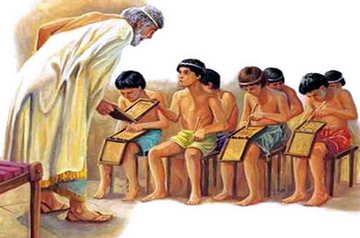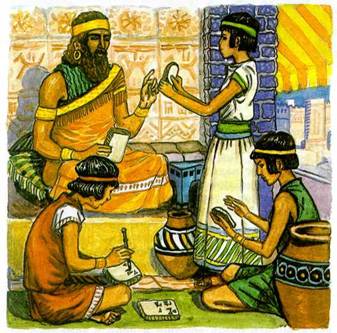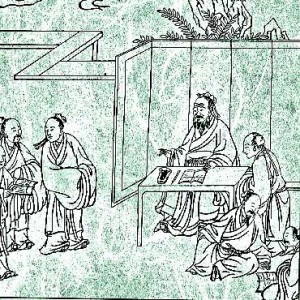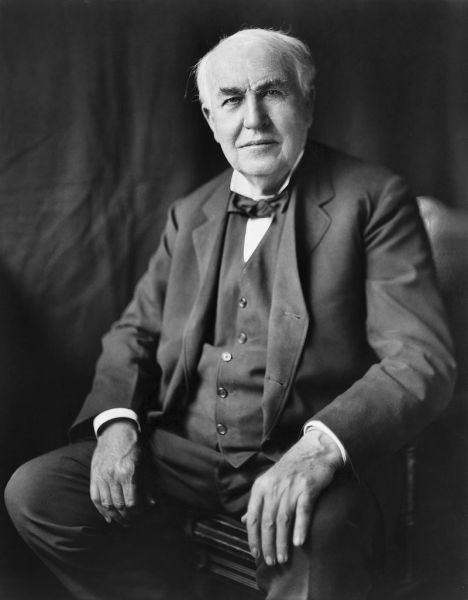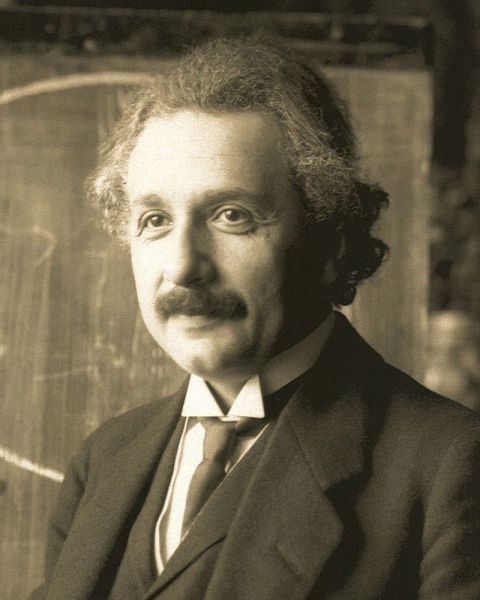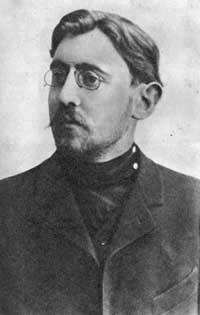Экзамены, тесты и всевозможные контрольные работы – пожалуй, главная головная боль всех студентов и школьников, грызущих гранит науки. А как бы обрадовались студенты, если б их не было! Но нет, экзамены и контрольные работы – главный метод проверки знаний учеников, и существовали они еще с глубокой древности, и наверняка будут существовать и в будущем. Точно ответить на вопрос кто придумал экзамены не возможно, вероятно они появились вместе с самими первыми образовательными учреждениями в истории. Например, уже в древнем Египте ученики готовились к экзаменам, так же как и их современные коллеги. Об истории экзаменов в разные времена и эпохи мы поговорим дальше в нашей статье.
Вступительные экзамены в древнем Египте
В древнем Египте как мы помним всей наукой и образованием ведали жрецы, которые были не только священнослужителями, но и учеными: астрономами, архитекторами, врачами, судьями, учителями. Чтобы обучатся искусству жрецов, необходимо было пройти через систему специальных испытаний, или, говоря современным языком – сдать вступительные экзамены в условный «древнеегипетский вуз» (разумеется, самого термина «вуз» в те времена еще не существовало). Сперва юный неофит (он же абитуриент) проходил процедуру, напоминающую современное собеседование: старшие жрецы выясняли его биографические данные, уровень образованности, внешний вид, умение вести беседу, и главное – мотивацию к обучению. Если собеседование проходило успешно, неофиту предстояло пройти еще несколько испытаний, в которых проверялось его умение трудиться, слушать и… молчать.
Это интересно: суровую систему египетских испытаний в свое время прошел и знаменитый древнегреческий ученый Пифагор, многому научившийся у египетских жрецов. Вернувшись в Грецию, он основал свою пифагорейскую школу, много элементов которой было позаимствовано у египтян.
Выпускные экзамены в древнем Вавилоне
В древнем Вавилоне, еще одной колыбели цивилизации, так же была своя система экзаменов для тех, кто желал заниматься интеллектуальным трудом, а не работать в поле. В частности там существовали выпускные экзамены для писцов, которые были в вавилонском обществе чем-то вроде современных программистов и инженеров: они не только вели экономическую и прочую деловую документацию, но и обладали другими полезными навыками, могли правильно измерить размер поля, разделить имущество. А во время экзаменов проверяли, в том числе не только каллиграфию, но и умение разбираться в тканях, металлах и растениях, а также знание арифметики и особенно геометрии. (Кажется что экзамены в современных дистанционных школах вроде https://onlineschool-1.ru/, не такие суровые как в древних аналогах).
Профессиональные экзамены в древнем Китае
В императорском Китае очень почетной была должность государственного чиновника, и не удивительно, что на нее существовал очень большой конкурс. Чтобы стать государственным чиновником необходимо было сдать специальный профессиональный экзамен, тему для которого подбирал сам китайский император, он же проводил непосредственно проверку знаний на заключительном этапе многоступенчатого отбора, призванного найти лучших из лучших.
Контрольные работы как письменная форма экзамена
В древности и средневековье экзамены в школах и университетах были устными, но постепенно стали вводится и письменные экзамены в виде контрольных работ, а потом и специально разработанных тестов. Но такая форма экзаменов первоначально вызывала протесты со стороны студентов. Например, в Англии письменные экзамены в виде контрольных работ стали использоваться в XVII веке, и то после почти двухсотлетней борьбы, а студенты Йельского университета в 1762 году даже опубликовали манифест против письменной формы экзаменов, в котором говорилось, что из-за них студентам приходится много «зубрить».
Автор: Павел Чайка, главный редактор исторического сайта Путешествия во времени
При написании статьи старался сделать ее максимально интересной, полезной и качественной. Буду благодарен за любую обратную связь и конструктивную критику в виде комментариев к статье. Также Ваше пожелание/вопрос/предложение можете написать на мою почту [email protected] или в Фейсбук, с уважением автор.
Схожі статті:
An exam, also known as a test or examination, is a method of assessing a person’s knowledge, skill, aptitude, physical fitness, or classification in many other topics. Exams are typically administered in a formal setting, such as a school, college, or workplace, and are used to evaluate a person’s understanding of a particular subject or to determine their qualifications for a particular job or role. Exams can be taken in many forms, including multiple-choice, short answer, essay, and practical demonstrations. The format and difficulty of exams vary depending on the purpose and level of the exam.
History:
One prominent figure in the development of modern exams in America was Henry F. Chauncey. He was an American educational administrator and psychologist who is credited with developing the first modern college admissions test, the College Board Scholastic Aptitude Test (SAT), which was first administered in 1926.
Before the development of the SAT, there was no standard method for evaluating the academic abilities of college applicants. Chauncey worked with a group of educators and psychologists to develop the SAT as a way to assess students’ aptitude for college-level work. The SAT quickly became widely used as a means of evaluating applicants for college admission and continues to be used today.
Chauncey’s work on the SAT was an important milestone in the development of modern exams and assessment systems in America and around the world. He and his colleagues made significant contributions to the field of educational psychology and helped to establish standardized tests as a widely used and accepted form of assessment.
Who Invented Exams in India?
The invention of exams as a form of assessment in India cannot be attributed to a single person, as it has been a long and ongoing process that has evolved over time. The development of modern exams and assessment systems in India has been a collaborative effort that has involved the contributions of many individuals and institutions, including educators, psychologists, researchers, and government agencies.
Types of Exams in India:
There are several types of exams that are commonly used to evaluate student learning and determine eligibility for higher education, government positions, and other important opportunities. Some of the most common types of exams in India include:
- School Exams: These exams are used to evaluate student learning in primary and secondary schools, and are typically taken at regular intervals throughout the school year.
- College Entrance Exams: These exams are used to determine eligibility for admission to colleges and universities, and are usually taken by students in their final year of secondary school.
- Professional Exams: These exams are used to assess the knowledge and skills required for specific professions, such as engineering, medicine, and law.
- Government Exams: These exams are used to determine eligibility for government positions, and are typically taken by individuals seeking employment in the public sector.
- Competitive Exams: These exams are used to determine eligibility for specific opportunities, such as scholarships, fellowships, and research grants, and are usually taken by individuals at different stages of their academic or professional careers.
These are some of the most common types of exams in India, and there are many others as well, each with its own specific requirements and evaluation criteria. Overall, exams play an important role in the Indian education system and continue to be an important tool for evaluating student learning and determining eligibility for a wide range of important opportunities.
Education in British India:
Education in British India was a complex and evolving system that changed over time in response to changing social, economic, and political conditions. During the colonial period, the British government in India established a system of education that aimed to create a cadre of educated Indians who could serve as intermediaries between the colonial authorities and the Indian population. This system was primarily focused on providing a Western-style education to the Indian elite, and was heavily influenced by the educational policies and practices of Britain.
In the early years of British rule in India, education was provided primarily by Christian mission schools, which emphasized the importance of religious education and conversion to Christianity. However, in the late 19th century, the British government began to establish a more formal system of education in India, with the goal of creating a class of educated Indians who could serve as intermediaries between the colonial authorities and the Indian population. This system was based on the British model of education, with a strong emphasis on classical subjects, such as Latin, Greek, and mathematics.
Over time, the education system in British India evolved to become more inclusive, with the introduction of primary and secondary schools and the expansion of university education. However, despite these developments, the education system remained heavily biased toward the Indian elite, and the majority of the Indian population remained illiterate.
Following independence in 1947, the Indian government made significant efforts to expand access to education and to create a more inclusive and equitable education system. These efforts have led to significant improvements in educational attainment and literacy rates, and have helped to establish India as one of the largest and most dynamic education systems in the world. Despite these achievements, however, India still faces significant challenges in terms of providing quality education to all its citizens and addressing disparities in educational attainment based on gender, class, and caste.
Advantages of Exams:
- Assessment of learning: Exams provide a means of evaluating a student’s knowledge and skills, and help to determine what they have learned over a period of time.
- Motivation: Exams can provide motivation for students to study and learn, as they give them a clear goal to work towards and a sense of accomplishment when they do well.
- Standardization: Exams help to ensure that students are being evaluated on a consistent basis and that their performance can be compared to that of their peers. This helps to create a level playing field for students and ensures that everyone is being held to the same standards.
- Feedback: Exams provide students with feedback on their performance, which can help them to identify areas where they need to improve and focus their efforts in these areas.
- Opportunities for growth: By taking exams, students are able to identify their strengths and weaknesses, and focus their efforts on areas where they need to improve. This can lead to growth and development in areas they may have previously struggled with.
- Career advancement: Exams can play a significant role in helping students to advance their careers, by demonstrating their knowledge and skills to potential employers.
- Certificates and Awards: Exams can also provide students with certificates and awards that they can use to demonstrate their achievements to others.
Overall, exams serve as a useful tool for assessing students’ knowledge and skills and can play an important role in helping students to achieve their goals and to grow and develop over time.
Challenges:
- High-stress levels: Exams can create a lot of stress and pressure for students, which can negatively impact their mental and physical health.
- Inequitable: Exams can be inequitable, especially for students who struggle with test-taking or who have learning disabilities.
- Limited scope: Exams only measure a limited scope of knowledge and skills, and do not always provide a comprehensive assessment of a student’s abilities.
- Unreliable results: Exams can sometimes produce unreliable results, due to factors such as guesswork, cheating, or technical errors.
- Narrow focus: Exams can create a narrow focus on memorization, rather than a broader emphasis on understanding and critical thinking.
- Inefficient: Exams can be time-consuming and resource-intensive, both for the students and the institutions that administer them.
Overall, while exams serve an important role in the assessment and can provide a useful measure of students’ knowledge and skills, they also have some significant drawbacks that should be taken into consideration.
FAQs:
Q1. What is the purpose of exams?
Answer: Exams are used to assess and evaluate a student’s knowledge and understanding of a subject. They provide an opportunity for students to demonstrate what they have learned and help teachers and institutions to determine their academic progress.
Q2) What types of exams are there?
Answer: There are several types of exams, including multiple-choice exams, short-answer exams, essay exams, and oral exams. The type of exam used depends on the subject and the goals of the assessment.
Q3) How often do exams take place?
Answer: The frequency of exams varies depending on the institution and the level of education. Some schools and universities have exams on a regular basis (e.g. monthly or quarterly), while others may have exams only once or twice a year.
Q4) How long do exams last?
Answer: The length of exams varies, depending on the type of exam, the level of education, and the number of questions. Some exams may last for a few hours, while others may last for a full day or more.
Q5) What happens if you fail an exam?
Answer: The consequences of failing an exam depending on the institution and the level of education. In some cases, a student may be required to repeat the exam or retake the course. In other cases, failing an exam may have no significant impact on the student’s academic progress.
Q6) How do exams impact your future?
Answer: Exams can have a significant impact on a student’s future, as they often determine whether they will advance to the next level of education, or be eligible for certain scholarships, grants, or jobs.
Q7) How can you prepare for exams?
Answer: There are several strategies for preparing for exams, including studying regularly, creating a study schedule, seeking help from teachers or tutors, and taking practice exams. The most important factor is to start preparing early and to be consistent in your studies.
An exam, also known as a test or examination, is a method of assessing a person’s knowledge, skill, aptitude, physical fitness, or classification in many other topics. Exams are typically administered in a formal setting, such as a school, college, or workplace, and are used to evaluate a person’s understanding of a particular subject or to determine their qualifications for a particular job or role. Exams can be taken in many forms, including multiple-choice, short answer, essay, and practical demonstrations. The format and difficulty of exams vary depending on the purpose and level of the exam.
History:
One prominent figure in the development of modern exams in America was Henry F. Chauncey. He was an American educational administrator and psychologist who is credited with developing the first modern college admissions test, the College Board Scholastic Aptitude Test (SAT), which was first administered in 1926.
Before the development of the SAT, there was no standard method for evaluating the academic abilities of college applicants. Chauncey worked with a group of educators and psychologists to develop the SAT as a way to assess students’ aptitude for college-level work. The SAT quickly became widely used as a means of evaluating applicants for college admission and continues to be used today.
Chauncey’s work on the SAT was an important milestone in the development of modern exams and assessment systems in America and around the world. He and his colleagues made significant contributions to the field of educational psychology and helped to establish standardized tests as a widely used and accepted form of assessment.
Who Invented Exams in India?
The invention of exams as a form of assessment in India cannot be attributed to a single person, as it has been a long and ongoing process that has evolved over time. The development of modern exams and assessment systems in India has been a collaborative effort that has involved the contributions of many individuals and institutions, including educators, psychologists, researchers, and government agencies.
Types of Exams in India:
There are several types of exams that are commonly used to evaluate student learning and determine eligibility for higher education, government positions, and other important opportunities. Some of the most common types of exams in India include:
- School Exams: These exams are used to evaluate student learning in primary and secondary schools, and are typically taken at regular intervals throughout the school year.
- College Entrance Exams: These exams are used to determine eligibility for admission to colleges and universities, and are usually taken by students in their final year of secondary school.
- Professional Exams: These exams are used to assess the knowledge and skills required for specific professions, such as engineering, medicine, and law.
- Government Exams: These exams are used to determine eligibility for government positions, and are typically taken by individuals seeking employment in the public sector.
- Competitive Exams: These exams are used to determine eligibility for specific opportunities, such as scholarships, fellowships, and research grants, and are usually taken by individuals at different stages of their academic or professional careers.
These are some of the most common types of exams in India, and there are many others as well, each with its own specific requirements and evaluation criteria. Overall, exams play an important role in the Indian education system and continue to be an important tool for evaluating student learning and determining eligibility for a wide range of important opportunities.
Education in British India:
Education in British India was a complex and evolving system that changed over time in response to changing social, economic, and political conditions. During the colonial period, the British government in India established a system of education that aimed to create a cadre of educated Indians who could serve as intermediaries between the colonial authorities and the Indian population. This system was primarily focused on providing a Western-style education to the Indian elite, and was heavily influenced by the educational policies and practices of Britain.
In the early years of British rule in India, education was provided primarily by Christian mission schools, which emphasized the importance of religious education and conversion to Christianity. However, in the late 19th century, the British government began to establish a more formal system of education in India, with the goal of creating a class of educated Indians who could serve as intermediaries between the colonial authorities and the Indian population. This system was based on the British model of education, with a strong emphasis on classical subjects, such as Latin, Greek, and mathematics.
Over time, the education system in British India evolved to become more inclusive, with the introduction of primary and secondary schools and the expansion of university education. However, despite these developments, the education system remained heavily biased toward the Indian elite, and the majority of the Indian population remained illiterate.
Following independence in 1947, the Indian government made significant efforts to expand access to education and to create a more inclusive and equitable education system. These efforts have led to significant improvements in educational attainment and literacy rates, and have helped to establish India as one of the largest and most dynamic education systems in the world. Despite these achievements, however, India still faces significant challenges in terms of providing quality education to all its citizens and addressing disparities in educational attainment based on gender, class, and caste.
Advantages of Exams:
- Assessment of learning: Exams provide a means of evaluating a student’s knowledge and skills, and help to determine what they have learned over a period of time.
- Motivation: Exams can provide motivation for students to study and learn, as they give them a clear goal to work towards and a sense of accomplishment when they do well.
- Standardization: Exams help to ensure that students are being evaluated on a consistent basis and that their performance can be compared to that of their peers. This helps to create a level playing field for students and ensures that everyone is being held to the same standards.
- Feedback: Exams provide students with feedback on their performance, which can help them to identify areas where they need to improve and focus their efforts in these areas.
- Opportunities for growth: By taking exams, students are able to identify their strengths and weaknesses, and focus their efforts on areas where they need to improve. This can lead to growth and development in areas they may have previously struggled with.
- Career advancement: Exams can play a significant role in helping students to advance their careers, by demonstrating their knowledge and skills to potential employers.
- Certificates and Awards: Exams can also provide students with certificates and awards that they can use to demonstrate their achievements to others.
Overall, exams serve as a useful tool for assessing students’ knowledge and skills and can play an important role in helping students to achieve their goals and to grow and develop over time.
Challenges:
- High-stress levels: Exams can create a lot of stress and pressure for students, which can negatively impact their mental and physical health.
- Inequitable: Exams can be inequitable, especially for students who struggle with test-taking or who have learning disabilities.
- Limited scope: Exams only measure a limited scope of knowledge and skills, and do not always provide a comprehensive assessment of a student’s abilities.
- Unreliable results: Exams can sometimes produce unreliable results, due to factors such as guesswork, cheating, or technical errors.
- Narrow focus: Exams can create a narrow focus on memorization, rather than a broader emphasis on understanding and critical thinking.
- Inefficient: Exams can be time-consuming and resource-intensive, both for the students and the institutions that administer them.
Overall, while exams serve an important role in the assessment and can provide a useful measure of students’ knowledge and skills, they also have some significant drawbacks that should be taken into consideration.
FAQs:
Q1. What is the purpose of exams?
Answer: Exams are used to assess and evaluate a student’s knowledge and understanding of a subject. They provide an opportunity for students to demonstrate what they have learned and help teachers and institutions to determine their academic progress.
Q2) What types of exams are there?
Answer: There are several types of exams, including multiple-choice exams, short-answer exams, essay exams, and oral exams. The type of exam used depends on the subject and the goals of the assessment.
Q3) How often do exams take place?
Answer: The frequency of exams varies depending on the institution and the level of education. Some schools and universities have exams on a regular basis (e.g. monthly or quarterly), while others may have exams only once or twice a year.
Q4) How long do exams last?
Answer: The length of exams varies, depending on the type of exam, the level of education, and the number of questions. Some exams may last for a few hours, while others may last for a full day or more.
Q5) What happens if you fail an exam?
Answer: The consequences of failing an exam depending on the institution and the level of education. In some cases, a student may be required to repeat the exam or retake the course. In other cases, failing an exam may have no significant impact on the student’s academic progress.
Q6) How do exams impact your future?
Answer: Exams can have a significant impact on a student’s future, as they often determine whether they will advance to the next level of education, or be eligible for certain scholarships, grants, or jobs.
Q7) How can you prepare for exams?
Answer: There are several strategies for preparing for exams, including studying regularly, creating a study schedule, seeking help from teachers or tutors, and taking practice exams. The most important factor is to start preparing early and to be consistent in your studies.
Экзамены (слово происходит от лат. examen, обозначавшее поначалу язычок, стрелку у весов, а уже затем оценку, испытание) появились ещё в середине III тысячелетия до нашей эры в Древнем Вавилоне в школах, где готовили писцов. У выпускников проверяли умение писать, а также разбираться в тканях, металлах, растениях и знания всех четырёх арифметических действий.
А в Древнем Египте для обучения искусству жрецов всем желающим предстояло пройти воистину суровые испытания. Поначалу новичков ждало что-то вроде собеседования: выясняли уровень образованности, биографию и разговорные навыки. Следующий этап: проверка умения трудиться, молчать и слушать. И, наконец, завершающий и самый сложный этап: испытания огнём, водой и угрозой смерти. Кстати, такие испытания преодолел, в частности, Пифагор, проходивший обучение в Египте, а вернувшись в Грецию, он основал школу с подобными испытаниями.
В Древнем Китае, например, учителя чань-буддизма проводили экзаменационные испытания с элементами психологического стресса. Учащиеся должны были быстро, не раздумывая отвечать на загадки и вопросы-парадоксы вроде «Была ли борода у бородатого варвара?» и «Имеет ли собака природу Будды?».
В Европе экзамены, более приближенные к современной форме, возникли в средневековых университетах при испытании на должности бакалавра и магистра. Например, по данным Лейпцигского университета, в 15-начале 16 века из 100 человек, записавшихся на слушание лекций, через два года экзамен держало 30 человек, а к выпускному экзамену явилось всего 6 человек. Как видим, сложность экзаменов тех времён не поддаётся сомнению, ведь за всё время обучения отсеялось 94 процента слушателей.
В 19 веке система экзаменов уже использовалась во всех европейских странах. В России, например, учреждением-первопроходцем, принявшим такую форму проверки знаний, как экзамен, была школа Э. Глюка, основанная в 1705 году в Москве. В 1837 году «Правилами для испытания в уездных училищах и гимназиях» приняты экзаменационные билеты и знакомая нам (правда, ставшая уже историей) пятибалльная система оценки знаний учащегося.
А в начале XX века появилось много противников экзаменационных испытаний из числа педагогов, считавших экзамены необъективными и склоняющими обучающихся к пустой механической «зубрёжке». Так, после Октябрьской революции 1917 года экзамены в СССР были отменены, но ненадолго, так как их отмена привела к существенному ухудшению знаний учащихся.
Конечно, экзамены – это тяжёлое испытание и существенная нагрузка на учеников, но всё же в необходимости их сомневаться не приходится. Остаётся только пожелать студентам грамотно распределить время и усилия на подготовку к экзаменам и заслуженный отдых. И тогда всё у вас получится. Ни пуха, ни пера!
Наверное, современным школьникам сложно себе представить, но экзамены сдавали еще ученики античного мира. В те времена далеко не все могли позволить себе учиться, но в школах уже проводилась проверка полученных знаний. А вот единые общенациональные экзамены впервые были введены в Древнем Китае. Главной целью этого экзамена было найти смышленных ребят, которые отбирались в будущем на государственные должности. А если учесть, что «государева служба» была раньше только честью для привилегированных граждан, то экзамен позволял попробовать свои силы, давая шанс вырваться из крестьян в государственные деятели, благодаря своему уму. Так что изначальная суть экзаменов была скорее благой целью, нежели попыткой измучить школьников.
Англичане, много путешествующие и изучающие лучший опыт зарубежных стран, взяли пример с Китайской империи и в 1806 году ввели в своей стране экзамены для всех желающих, чтобы отбирать лучших на службу в Королевский двор. Несомненно это было новаторским ходом в те времена, во всей Европе подобного еще не встречалось. Но практика распространилась быстро, система экзаменов внедрилась в процесс обучения и стала вводиться в образовательных учреждениях всего мира.
Для Российской империи 19 век также ознаменовался появлением системой образования, открывались гимназии, лицеи, кадетские школы. Это могла быть как государственная, так и частная школа, хотя последние на начальном этапе появления образования встречались чаще, а потому и обучать своих детей в то время могли только состоятельные люди.
Рост государственных школ, в которых мог обучаться любой ребенок, независимо от материального статуса и семейного положения, произошел уже в СССР. Прежде же во всем мире, и в царской России в частности, считалось, что большинство детей из рабочих и крестьянских семей не сможет обучиться письму и чтению, в связи с чем вовсе не стоит тратить на них государственные время и деньги. Знаете ли вы, что до сих пор в мире существуют такие регионы, в которых нет бесплатного государственного образования. И многие дети, чьи родители не в состоянии оплачивать огромные счета за образование, обречены всю жизнь быть только лишь крестьянами или фермерами. Поэтому мы должны ценить то, что у нас есть шанс на лучшую жизнь, а использовать его или нет, дело каждого.
В советских школах экзамены состояли, как правило, из двух основных частей — устной и письменной. В устной части нужно было рассказать весь выученный материал по тому билету, который ученик вытянул. Письменная часть включала в себя решение задач, расчет данных и написание сочинения или изложения (в зависимости от предмета). Для старших классов был введен основной государственный экзамен, включавший в себя одинаковые для всей страны задания. В то время тоже встречались курсы подготовки к ОГЭ, но в основном ученики были неплохо подготовлены, так как за годы учебы какие-то знания да остались, а сам экзамен был не в виде теста, а потому преподаватели могли более объективно оценить уровень знаний школьника.
В начале нового 21 века в русских школах был введен единый государственный экзамен. Изначально это было целью сделать систему образования более стандартизированной, но до сих пор не утихают споры по поводу того, вреден или полезен ЕГЭ. Ежегодно он видоизменяется и дополняется новыми типами заданий и вопросов, а потому, чтобы экзамен был успешно сдан ребенком, родителям будущих выпускников приходится держать руку на пульсе, оплачивать дополнительные курсы подготовки к ЕГЭ, заниматься с педагогами, покупать различные книги. Но в конце концов во всем мире требования к образованию повышаются, ведь сегодня появляется множество новых профессий и видов деятельности.
Ясно одно, что экзамены уже прочно вошли в нашу жизнь и лучшего способа проверить уровень знаний на данный момент нет и в ближайшее время вряд ли будет. Сегодня экзамены могут быть как устными, так и письменными, в виде тестов на бумаге или на компьютере. Придумываются разные способы сдачи экзаменов, но сама их суть от этого не изменяется.
( 1 оценка, среднее 5 из 5 )
От соискателей работы не потребовали предъявить какие-либо дипломы, рекомендательные письма или заполнить обычные анкеты. Вместо этого их попросили ответить на 163 вопроса (почему именно такое число — неизвестно). Вопросы были самые разные…
Какой материк больше — Австралия или Гренландия?
Из какого дерева делают бочки для керосина?
Какую машину изобрёл Джеймс Уатт?
Какая гора — самая высокая в мире?
И т.д.
Фото: ru.wikipedia.org
Из 718 человек, откликнувшихся на объявление, только 57 правильно ответили на более чем 70% вопросов (это был «проходной балл»), и только 32 из них — на 92% и более. Эдисон проверил на вопроснике также своих сотрудников, и те из них, кто не ответил на 70% вопросов, были уволены.
Хотя претендентов на работу просили о вопросах никому не говорить, известие о них просочилось в СМИ. Проверять свои знания бросились многие читатели газет и журналов, их стали задавать, как каверзные, известным людям и знаменитостям. Пришлось Эдисону разработать новый вопросник. Дело получило широкую огласку, вопросники-тесты вошли в моду.
Позже американский психолог К. Бригем разработал тесты для школьников, основные принципы составления которых нашли применение во многих странах, но особенно широко (хотя и не сразу) — в США. Печальные последствия этого для США достаточно известны: многие ученики кончают школу, не умея читать и писать. Но американцы не унывают — закупают мозги за рубежом, предпочитая страны, где обходятся без тестирования, особенно те, где образование организовано по советскому образцу. Так как сейчас ЕГЭ стал обязателен в России, видимо, скоро отток кадров из России в США иссякнет.
Фото: ru.wikipedia.org
Когда общеизвестный физик и математик А. Эйнштейн посетил США, газетчики, конечно же, попросили его высказаться по поводу вопросника Эдисона. Эйнштейн ответил, что ему незачем держать в памяти, например, величину скорости звука (кстати, а многие ли читатели ШЖ её помнят?), если о ней можно узнать в справочниках (сейчас бы он сказал — в Интернете). Из этого случая родился анекдот, актуальный и сейчас.
«При встрече с Эйнштейном Эдисон показал ему свой вопросник. Ознакомившись, Эйнштейн с огорчением отметил, что ему не удалось бы устроиться работать к Эдисону».
Для поддержания имиджа тестирования, весьма подмоченного качеством общедоступного среднего образования в США, в Америке тиражируется такой случай, сделанный легендой (один из вариантов американской мечты).
В 1929 году Эдисон «с группой товарищей» объявили общеамериканский конкурс на звание «самого умного школьника Америки» (слямзили, наверное, с нашего телеконкурса «Умники и умницы»). Из множества участников, 49 из которых вышли в финал, победил 16-летний школьник У. Хьюстон. За свою победу он получил стипендию для продолжения образования в Массачусетском технологическом институте (вот жмоты, дали только одну стипендию; наше ТВ куда щедрее). Впоследствии У. Хьюстон стал одним из руководителей НАСА.
Фото: ru.wikipedia.org
В общем, ставь крестики в клеточки теста и станешь президентом. Интересно, что наш известный популяризатор науки Я. И. Перельман перевёл и издал отдельной книжкой физические и математические задачи из этого конкурса. В предисловии он написал, что «особой замысловатостью они не отличаются и для наших школьников последних классов вполне посильны».
Вообще-то, впервые в той форме, в которой ЕГЭ пытаются проводить у нас, его начали использовать во Франции в 1967 году. Дело в том, что после освобождения бывших французских колоний там осталось много граждан Франции, доступ которым к высшему образованию во Франции закрылся. Чтобы помочь соотечественникам, французские власти решили вместо вступительных экзаменов проводить ЕГЭ на местах (в смысле — в бывших колониях), а лучших сразу же зачислять в вузы.
Эксперимент длился 3 года и с треском провалился, потому что уровень высшего образования во Франции резко снизился. За Францией тот же печальный путь прошли и США (внедряли, кстати, как это ни странно, французы). И сейчас тестирование повсеместно — только один из пунктов допуска к вступительным экзаменам, а в США для поступления в колледж без экзамена надо представить ещё огромный перечень всяких других документов.
В заключение хотелось бы сказать: зря Эдисон изобрёл ЕГЭ. Это, видимо, такое же его малополезное изобретение, как постоянный ток. И очень странно, что ЕГЭ пытаются внедрить у нас, зная заведомо, что оно везде провалилось. В такой форме, как у нас, ЕГЭ ни в одной стране мира не существует! Те, кто с упорством, достойным лучшего применения, настырно пробивают ЕГЭ, на мой взгляд, преследуют две главные цели.
Фото: Depositphotos
- Первая (явная) — добиться из госбюджета огромных инвестиций и права их «распределять».
- Вторая (тайная) — окончательно развалить наше, пока ещё лучшее в мире, качество образования.
Тем огромным средствам, которые тратятся на ЕГЭ, можно найти гораздо лучшее применение: отремонтировать школы, повысить зарплату учителям, увеличить средства на питание младших школьников и т. д. Но это, видимо, не входит в число приоритетов тех, кто даёт и тратит наши денежки.

